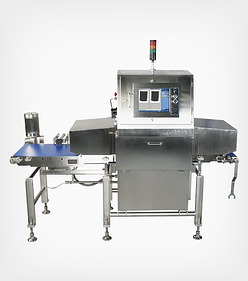 DEXA, or Dual Energy X-ray Absorptiometry, is a game-changing product inspection technology for the meat production industry.
DEXA, or Dual Energy X-ray Absorptiometry, is a game-changing product inspection technology for the meat production industry.
This technology expands on the capabilities of traditional x-ray product inspection technology by using two separate x-ray energy wavelengths, one high-energy wave and one low-energy wave.
By contrasting the rate at which these high and low-energy waves are absorbed by the materials they’re passed through, DEXA systems can analyze their chemical composition.
Uses of DEXA Technology for Meat Inspection
The ability of DEXA systems to analyze the chemical composition of product passing underneath it gives this technology a wealth of uses for meat inspection. These uses include:
- Contaminant Detection. DEXA units can be used for detecting foreign bodies in meat—just like traditional x-ray systems. However, DEXA inspection machines can detect a wider variety of contaminants than traditional x-ray machines such as:
- Small Bones
- Buck Shots (lead)
- Metals
- Glass
- Stones
- High Density Plastic and Rubber
- Gravity Flow Inspection. Because traditional x-ray systems rely on an x-ray picture for analyzing product, they’re less than ideal for scanning product with complicated shapes or product that is rapidly flowing in bulk. Because DEXA systems detect chemical composition rather than using pictures, they’re better able to scan loose-packed ground meats accurately.
- Chemical Lean (CL) Inspection. DEXA machines are frequently used to check the chemical lean (aka fat content) of meat products. Old-fashioned tests such as the Soxhlet method destroy the meat, meaning only small samples can be tested. DEXA technology can examine 100% of all meat non-destructively in a fraction of the time, increasing thoroughness, speed, and accuracy of CL valuations.
- Moisture and Protein Calculations. In addition to the CL, DEXA systems can easily and quickly calculate the moisture and protein of the meat. This provides all of the required data to allow meat processors the ability to achieve best possible Least Cost Formulating (LCF) and more efficient meat inventory usage.
- Bulk Meat Blend Control. Because DEXA systems can accurately check the CL value of meat, many meat processors use it to control upstream feeds of bulk loads of meat that have different CL values to create combined batches with a target CL value.
Benefits of DEXA Technology
By combining both safety checks such as contaminant detection with chemical lean inspection, DEXA machines can save meat processors significant amounts of time and money.
The ability to check up to 160 tons of meat for fat content in one hour makes DEXA far more efficient at inspecting meat product than destructive lab tests such as the Soxhlet method. The ability to simultaneously check for contaminants such as bone, rock, metal, plastic, and rubber fragments saves time and reduces the need for an additional inspection station.
However, the biggest advantage of using DEXA technology for meat inspection is the overall thoroughness and accuracy of the process. By being so accurate (1 CL accuracy or better), and by testing 100% of the meat coming through the production line, DEXA systems empower meat processors to vastly increase the accuracy of their fat content labeling.
This means less money lost to fat claims and the under-labeling of lean meats.
Learn more about how you can use DEXA inspection systems to protect your business, increase quality, boost productivity, and reduce costs today!




